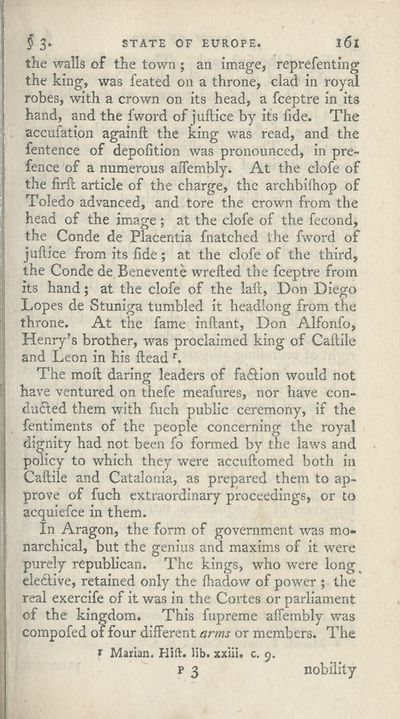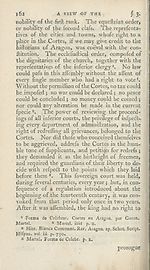Download files
Complete book:
Individual page:
Thumbnail gallery: Grid view | List view

§ 3" STATE OF EUROPE. l6l
the walls of the town ; an image, reprefenting
the king, was feated on a throne, clad in royal
robes, with a crown on its head, a fceptre in its
hand, and the fword of juftice by its fide. The
accufation againft the king was read, and the
fentence of depofition was pronounced, in pre¬
fence of a numerous aifembly. At the clofe of
the firft article of the charge, the archbifhop of
Toledo advanced, and tore the crown from the
head of the image ; at the clofe of the fecond,
the Conde de Placentia fnatched the fword of
juftice from its fide ; at the clofe of the third,
the Conde de Benevente wrefted the fceptre from
its hand; at the clofe of the laft, Don Diego
Lopes de Stuniga tumbled it headlong from the
throne. At the fame inftant, Don Alfonfo,
Henry’s brother, was proclaimed king of Caftile
and Leon in his ftead r.
The moft daring leaders of faftion would not
have ventured on thefe meafures, nor have con¬
ducted them with fuch public ceremony, if the
fentiments of the people concerning the royal
dignity had not been fo formed by the laws and
policy to which they were accuftomed both in
Caftile and Catalonia, as prepared them to ap¬
prove of fuch extraordinary proceedings, or to
acquiefce in them.
In Aragon, the form of government was mo¬
narchical, but the genius and maxims of it were
purely republican. The kings, who were long_
eledtive, retained only the (hadow of power ; the
real exercife of it was in the Cortes or parliament
of the kingdom. This fupreme affembly was
compofed ox four different arms or members. The
x Marian. Hift. lib. xxiii. c. 9.
r 3
nobility
the walls of the town ; an image, reprefenting
the king, was feated on a throne, clad in royal
robes, with a crown on its head, a fceptre in its
hand, and the fword of juftice by its fide. The
accufation againft the king was read, and the
fentence of depofition was pronounced, in pre¬
fence of a numerous aifembly. At the clofe of
the firft article of the charge, the archbifhop of
Toledo advanced, and tore the crown from the
head of the image ; at the clofe of the fecond,
the Conde de Placentia fnatched the fword of
juftice from its fide ; at the clofe of the third,
the Conde de Benevente wrefted the fceptre from
its hand; at the clofe of the laft, Don Diego
Lopes de Stuniga tumbled it headlong from the
throne. At the fame inftant, Don Alfonfo,
Henry’s brother, was proclaimed king of Caftile
and Leon in his ftead r.
The moft daring leaders of faftion would not
have ventured on thefe meafures, nor have con¬
ducted them with fuch public ceremony, if the
fentiments of the people concerning the royal
dignity had not been fo formed by the laws and
policy to which they were accuftomed both in
Caftile and Catalonia, as prepared them to ap¬
prove of fuch extraordinary proceedings, or to
acquiefce in them.
In Aragon, the form of government was mo¬
narchical, but the genius and maxims of it were
purely republican. The kings, who were long_
eledtive, retained only the (hadow of power ; the
real exercife of it was in the Cortes or parliament
of the kingdom. This fupreme affembly was
compofed ox four different arms or members. The
x Marian. Hift. lib. xxiii. c. 9.
r 3
nobility
Set display mode to:
![]() Universal Viewer |
Universal Viewer | ![]() Mirador |
Large image | Transcription
Mirador |
Large image | Transcription
| Antiquarian books of Scotland > Kings & rulers > History of the reign of the Emperor Charles V. > Volume 1 > (179) |
|---|
| Permanent URL | https://digital.nls.uk/109184479 |
|---|
| Description | By William Robertson. London : Cadell and Davies, 1798. |
|---|---|
| Shelfmark | ABS.1.76.13 |
| Additional NLS resources: | |
| Description | Thousands of printed books from the Antiquarian Books of Scotland collection which dates from 1641 to the 1980s. The collection consists of 14,800 books which were published in Scotland or have a Scottish connection, e.g. through the author, printer or owner. Subjects covered include sport, education, diseases, adventure, occupations, Jacobites, politics and religion. Among the 29 languages represented are English, Gaelic, Italian, French, Russian and Swedish. |
|---|

